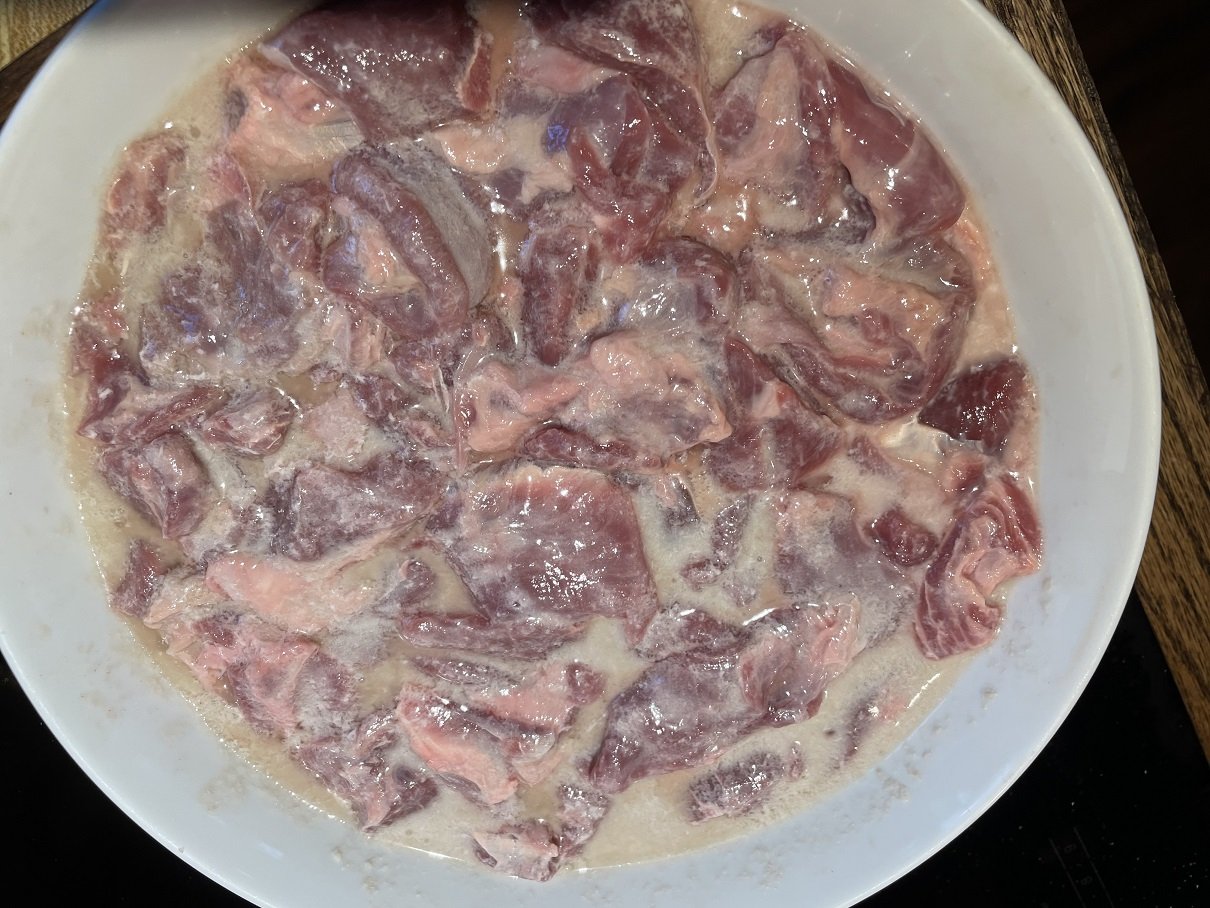Once the onions are sufficiently carmelized, add one cinnamon stick, a few cloves, dried or fresh mint (if you have it), 3-5 cardamom pods or a few pinches of ground cardamom, 2-3 bay leaves (if you have them), a few pinches of mace (if you have it, otherwise use extra nutmeg), and either a garam masala mix OR about half a nutmeg (ground), ground black pepper, several shakes of ground cumin and of ground coriander, and several shakes of cinnamon. If you want, add a bit of chili powder. Turn up the heat and cook and stir the onions with the spices for about another minute. The most important flavors here are the carmelized onion, the cardamom, nutmeg or mace, cumin, coriander, cinnamon, and cloves. I don’t like giving spice measurements because it depends on how strong you like the flavors and how old your spices are. Try roughly equal parts cumin and coriander, slightly more than that of cinnamon, even more than that of cardamom, and a whole heck of a lot of nutmeg, maybe 50:50 with mace if you have it. As mentioned, you could substitute out some of these for a curry powder mix if that is all you have, just read the ingredients.
Simmer the Mutton Until Tender
Add in the mutton along with its marinade. Add chopped cilantro, or parsley if you don’t like cilantro, or some other green herb that reminds you of cilantro or parsley (we used papalo). Stir everything to combine. Add about 2 cups of water and bring to a boil. Add extra salt to taste. I like to add chicken bouillon, not really for the weird stuff and the chicken flavor but for the MSG. I know, OMG, I thought you were about natural food, MSG is extracted from….seaweed, and L-glutamic acid is in a whole bunch of different kinds of natural foods. Hey, you do you, leave it out if you don’t like it. If you cooked the onions in lard and not ghee, consider adding a couple tablespoons of butter, for flavor. If you cooked the onions in some kind of hydrogenated vegetable oil, pack up your backpack and go to the principal’s office right now.
Turn the heat down, put the lid on, and simmer the mutton for several hours, stirring occasionally until it is tender. The cooking liquid should be bubbling but not popping boiling hot bubbles in your face. When done, you should be able to cut a piece of mutton in half with a wooden spatula. If the meat is not that tender, keep cooking, and add more liquid if necessary.
Prep the Rice
Meanwhile, rinse your rice (most rice has arsenic in it — which is probably not a big deal if you have a healthy immune system and you rinse it), then soak the rice in a pot of water, at least twice as much water as rice. (You can change out the water before cooking if you’re that kind of person.) When the mutton is close to tender, add to the rice pot a few tablespoons of butter, a pinch of salt (if to your taste), a jigger of lemon juice, some extra cardamom (pods or ground), and a healthy dose of turmeric. You can do without the turmeric if you want, it’s mostly to color the rice yellow, because saffron is really, really, really expensive. Bring the rice mixture to a rolling boil for just 2 minutes. Drain the rice (a mesh strainer is helpful but not strictly necessary.) Yes, you are wasting most of the flavorings since you only boiled the rice for 2 minutes. You could save the liquid and use it later as a base to cook another batch of rice.
Finish the Mutton, Steam the Rice
Take the lid off the mutton and crank up the heat, stirring while you reduce the cooking liquid until it’s still there but you can see the mutton above the top of the liquid. It’s better to err on the side of a little extra broth so you make sure there is enough liquid to finish steaming the rice. Then reduce the heat to low. Spread the parboiled rice evenly over the top of the mutton. Decorate (optionally) by sprinkling something like dried cranberries over the top.
Cover the cooking pot tightly. One way to do this is to seal it with aluminum foil and then put the lid on top of that. Steam the rice like this for around 30 minutes before checking to see if the rice is done.
Make a Raita
When the rice is steamed the biryani is done. It is best served with some kind of a raita, such as plain yogurt mixed with minced cucumber and chopped, fresh mint. By which I mean, ignore complicated raita recipes and chop up half a cucumber and a handful of mint, then mix it into a cup or so of plain yogurt.
Remember to take out the bay leaves and whole spices or at least warn people to watch out for them. Or don’t.










